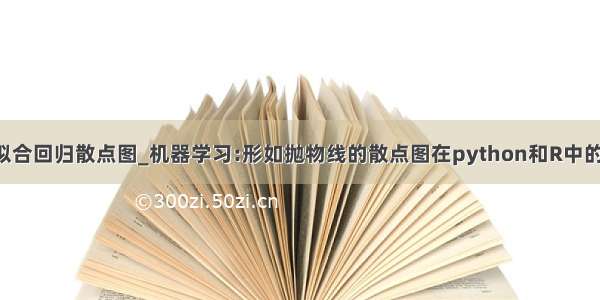
目录
绘制直方图绘制散点图线性回归多项式回归拟合度数据分析就是在一大批杂乱无章的数据中,运用数字化工具和技术,探索数据内在的结构和规律,构建数学模型,并进行可视化表达,通过验证将模型转化为知识,为诊断过去、预测未来发挥作用。
一个数据库的例子:
Carname=[ ]
Color=[ ]
Age=[5,7,8,7,2,17,2,9,4,11,12,9,6]
Speed=[99,86,87,88,111,86,103,87,94,78,77,85,86]
Autopass=[ ]
绘制直方图
为了可视化数据集,我们可以对收集的数据绘制直方图。我们将使用 Python 模块 Matplotlib 绘制直方图。
#车辆年龄直方图import matplotlib.pyplot as pltages = [5,7,8,7,2,17,2,9,4,11,12,9,6]plt.hist(ages, 3,rwidth=0.97)plt.show()
绘制散点图
散点图是数据集中的每个值都由点表示的图.
#绘制年龄和速度散点图import matplotlib.pyplot as pltage = [5,7,8,7,2,17,2,9,4,11,12,9,6]speed = [99,86,87,88,111,86,103,87,94,78,77,85,86]plt.scatter(age,speed)plt.show()
通过看图发现数据的发展趋势是什么?(线性回归)
线性回归
import matplotlib.pyplot as pltfrom scipy import statsx = [5,7,8,7,2,17,2,9,4,11,12,9,6]y = [99,86,87,88,111,86,103,87,94,78,77,85,86]slope, intercept, r, p, std_err = stats.linregress(x, y)def myfunc(x):return slope * x + interceptmymodel = list(map(myfunc, x))plt.scatter(x, y)plt.plot(x, mymodel)plt.show()
通过线性回归可以预测9年的车辆速度是多少?
from scipy import statsx = [5,7,8,7,2,17,2,9,4,11,12,9,6]y = [99,86,87,88,111,86,103,87,94,78,77,85,86]slope, intercept, r, p, std_err = stats.linregress(x, y)def myfunc(x):return slope * x + interceptspeed = myfunc(9)print(speed)
x = [89,43,36,36,95,10,66,34,38,20,26,29,48,64,6,5,36,66,72,40]
y = [21,46,3,35,67,95,53,72,58,10,26,34,90,33,38,20,56,2,47,15]
x 和 y 轴的这些值将导致线性回归的拟合度非常差:
在下面的例子中,我们注册了 18 辆经过特定收费站的汽车。
我们已经记录了汽车的速度和通过时间(小时)。
import matplotlib.pyplot as pltx = [1,2,3,5,6,7,8,9,10,12,13,14,15,16,18,19,21,22]y = [100,90,80,60,60,55,60,65,70,70,75,76,78,79,90,99,99,100]plt.scatter(x, y)plt.show()
多项式回归
import numpyimport matplotlib.pyplot as pltx = [1,2,3,5,6,7,8,9,10,12,13,14,15,16,18,19,21,22]y = [100,90,80,60,60,55,60,65,70,70,75,76,78,79,90,99,99,100]mymodel = numpy.poly1d(numpy.polyfit(x, y, 3))myline = numpy.linspace(1, 22, 100)plt.scatter(x, y)plt.plot(myline, mymodel(myline))plt.show()
那怎么判断是否适合线性回归还是多项式回归呢?
拟合度
#线性回归拟合度import numpyfrom scipy import statsx = [89,43,36,36,95,10,66,34,38,20,26,29,48,64,6,5,36,66,72,40]y = [21,46,3,35,67,95,53,72,58,10,26,34,90,33,38,20,56,2,47,15]slope, intercept, r, p, std_err = stats.linregress(x, y)print(r)
#多项式回归拟合度import numpyfrom sklearn.metrics import r2_scorex = [1,2,3,5,6,7,8,9,10,12,13,14,15,16,18,19,21,22]y = [100,90,80,60,60,55,60,65,70,70,75,76,78,79,90,99,99,100]mymodel = numpy.poly1d(numpy.polyfit(x, y, 3))print(r2_score(y, mymodel(x)))
















